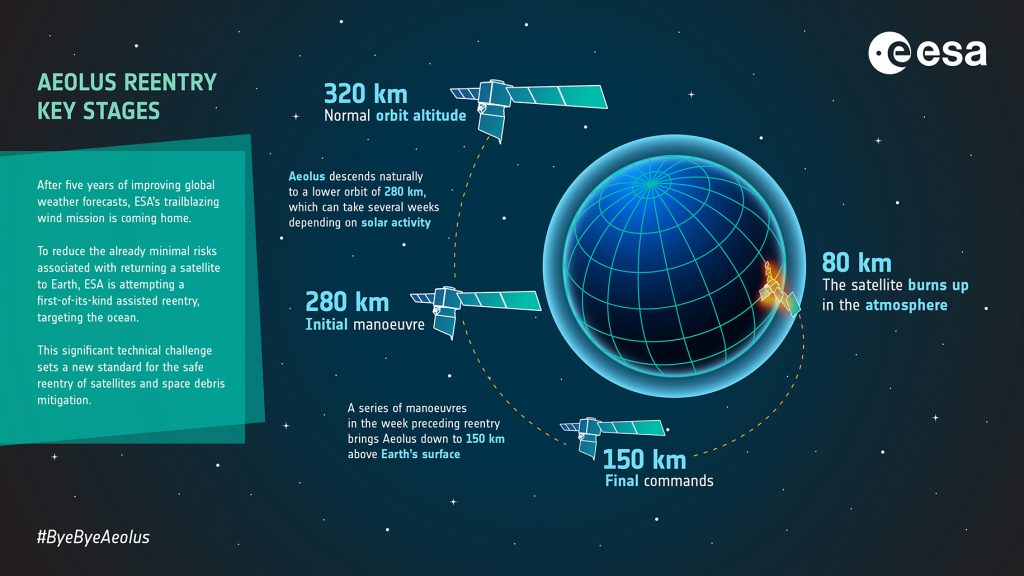ESA’s keeper of the winds is coming home.
After completing its mission, Aeolus has been falling from its operational altitude of 320 km since 19 June.
Operators at ESA mission control in Germany have been keeping a close eye on Aeolus. As soon as it reaches 280 km on Monday 24 July, using the last of Aeolus’ fuel, the first of several critical manoeuvres will be performed to steer ESA’s wind satellite slowly back to Earth.
The final manoeuvre is scheduled for Friday 28 July, when a final command will guide Aeolus home from an altitude of 150 km to just 120 km. Then, the satellite will reenter.
At around 80 km, most of the satellite will burn up, but a few fragments may reach Earth’s surface.

Where will Aeolus reenter?
Mission scientists and engineers have worked tirelessly to calculate the optimal orbit for Aeolus to reenter Earth, which targets a remote stretch of the Atlantic ocean.
The general risk from reentering satellites is already very low. For example, the risk of an individual being hit by a piece of space debris is approximately three times lower than the risk from a falling meteorite.
By targeting the Atlantic ocean, which offers the best satellite visibility during the critical final reentry phases, the attempt will further reduce the risk of Aeolus’ reentry by 42 times compared to a natural reentry.
The pioneering attempt to assist Aeolus’ reentry is a complex and novel task. It might not work. However, if at any stage the attempt must be aborted, Aeolus will reenter naturally as originally planned.
Successful or not, the attempt paves the way for the safe return of active satellites that were never designed for controlled reentry.

Discussion: 2 comments
Thank you for an interesting and informative article. However, it leaves me with a couple of questions. First, what exactly is the difference between assisted and controlled re-entry? From the description here, “assisted” seems quite like “controlled” but less accurate. Is there a more qualitative difference? Second question: what is the technical feature/limitation in Aeolus that prevents performing a fully controlled re-entry?
Hi Tiera,
Thanks for your question, its a good one!
To be a controlled reentry, the satellite needs to be manoeuvred down to an altitude of ~50 km. As Aeolus was designed only for a natural descent, its not possible for us to fully control it at this stage – it would need a different propulsion system, more fuel, etc.
Its taken a lot of work from teams to find out what’s possible with the satellite as it is, what manoeuvres they can do with it in the final moments and how low they can get it. Going from a natural descent to an assisted/semi-controlled descent is already pushing the boundaries of what the spacecraft can do.
Best wishes
Rosa